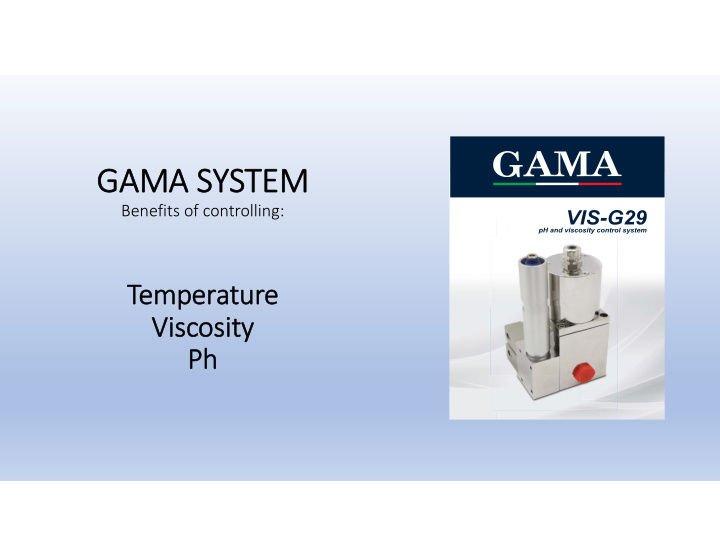



GAM GAMA SYSTEM SYSTEM Benefits of controlling: Te Temperature Vi Visc scosity osity Ph Ph
Bene Benefits fits of of Con Controllin lling of of Ink Ink Te Temperature Cutting Cos Cut Costs and and Im Improvin ing Pr Print Quality lity Study conducted by the EPA, UT, WMU and GAA Assumption: Controlling ink temperature will result in cost benefits, an increase in print quality and environmental benefits.
Temperature Control Study Press size: 23" wide / Printing units: 3 / Annual operation time: 7200 hr/yr / Press speed: 300 ft/min Solvent use rate per color: 9 lb/hr at 92 degrees F 4 lb/hr at 79 degrees F Ink use rate per color: 6 lb/hr at 92 degrees F 4 lb/hr at 79 degrees F Ph or Solvent cost: $0.50/lb Ink cost: $4.00/lb During run, ink temp and viscosity was tested every 5 minutes. Print quality measurements every 20 minutes. Scenario 1: NW printer operates a 92 F three months, 79 F for nine. Scenario 2: Printer implements temperature control. Maintains 79 F all year.
Narrow Web Trial – Annual Ink Savings Scenario 1 Scenario 2 Savings Average Temp (degrees F) 88.75 79 Evaporation / Emissions (lbs/yr) 113,400 86,400 27,000 Ink Consumption (lbs/yr) 97,200 86,400 10,800 Annual Emissions Costs $56,700 $43,200 $13,500 Annual Ink Costs $388,800 $345,600 $43,200 Annual Total Costs $445,500 $388,800 $56,700 savings
Figure 1 Total Emissions Consumption (Evaporation) 11.8 Magenta Cyan 7.2 4.2 4 4 3.5 °F 79 °F 92 °F 66 Ink Temperature
Figure 2 Ink Consumption 7.8 Magenta Cyan 5.6 4.5 4 3 1.6 66 °F 79 °F 92 °F InkTemperature
Summa mmary In examining the total mass of the ink consumed during the trial, 10% was saved by just lowering the temperature from 92 to 79 degrees for the three months in the summer. In addition, here is what to expect at all the temperature levels tested. Temperature Increase Increase in Ink Consumption 66 to 79 Degrees F 9% to 28% increase 79 to 92 Degrees F 37% to 56% increase How does this translate to the Corrugated and Wide Web Industry? You can expect to save a minimum of 10% in ink costs, sometimes double.
Corrug Corrugated Ind Industry ry Sa Savings vings What Wh at if if yo your in ink aver erag aged ed 80 80 degr degrees, s, but but wa was main intain ined at at 72 72 movi moving ng fo forward? Due to the environment the ink is exposed to in the Corrugated Industry, you can expect press side ink to average about 80 degrees over the course of the year. If maintained at 72 degrees, this study shows a savings of $1.86/hr in ink consumption per print deck on a NW press. However, the anilox roll size in the Corrugated Industry is +10 times the roll size in this study. Therefore, the ink exposed to evaporation is increases dramatically as well as the total amount of ink used. Expect to save, at a minimum, three times or $5.58/hr on a corrugated press operating at the same speed, and maintaining temperature at 72 degrees . Here is an estimate on the cost savings for a flexo in the Corrugated Industry.
Annual Corrugated Ink Savings Ink Temperature (80 degree to 72 degrees) Hours of Operation Ink Savings / Down 1C Press 2C press 3C press c 1 shift 5 days / 52 weeks (2,080 hrs) $ 11,606 $ 23,213 $ 46,426 2 shifts 5 days / 52 weeks (4,160 hrs) $ 23,213 $ 46,426 $ 92,852
Wide Web Flexible Pkg Expect similar ink savings. Although the anilox roll and the inks exposure to the environment is about half of the Corrugated Industry, the press speeds are typically many times faster. In addition, ink temperatures increase faster due to the speed of these presses and the friction and shearing of the ink that occurs in the chambers.
Print Quality Improvements Test showed warmer inks evaporated faster, causing screening and wettability problems. As inks rose to 92 degrees, the ink dried before spreading adequately on the substrate, reducing overall coverage. Printed tones (dots) most affected. The finest dots did not print at all.
Figure 7 Magenta solid – Wettability Issue 92 °F 79 °F
Figure 5 Magenta (25% dot – 150 lpi) °F °F 79 92 Figure 6 Cyan (25% dot ‐ 150lpi) °F °F 92 79
Benefits of Controlling Viscosity (# 2 Zahn Cup – 18 vs 21 vs 24 viscosity on bleached kraft) 14 R. Wiesemann CRI revised 2009 05 22
The GAMA system controls temperature, Ph and viscosity, independently. Benefits of using a GAMA ‐ Saves money by controlling Temperature ‐ Improves print quality ‐ Controls Ph ‐ Inks remain consistent ‐ Plates/anilox/press components stay cleaner ‐ Controls viscosity ‐ Flatlines color ‐ Reduces down time for color matching ‐ Reduces print defects ‐ Frees up operator labor
Recommend
More recommend